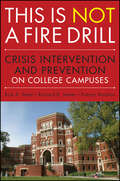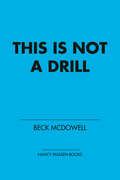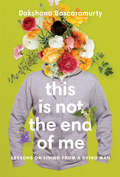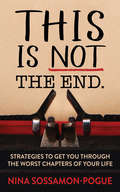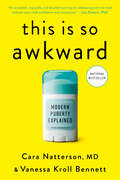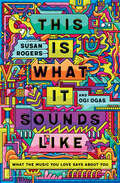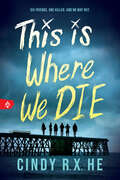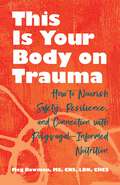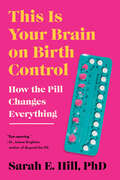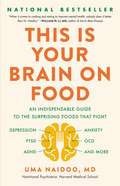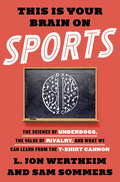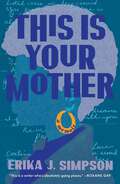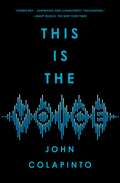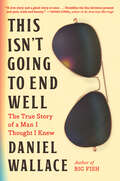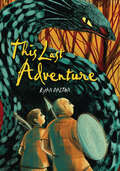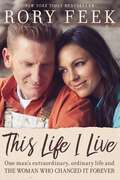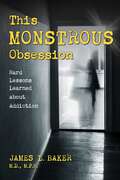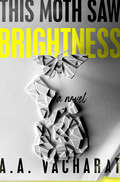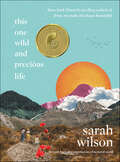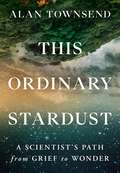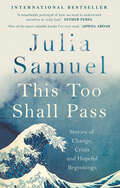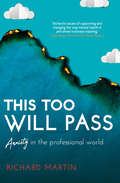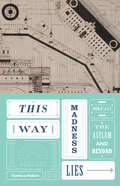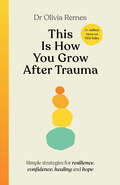- Table View
- List View
This Is NOT a Fire Drill
by Rick A. Myer Richard K. James Patrice MoultonPractical Information and Tools to Create and Implement a Comprehensive College Campus Crisis Management Program Written by three seasoned crisis intervention/prevention specialists with over fifty years combined experience in the field, This is NOT a Fire Drill: Crisis Intervention and Prevention on College Campuses is a practical guide to creating a comprehensive college campus crisis management program. Authors Rick Myer, Richard James, and Patrice Moulton provide university administrators, faculty, and staff with invaluable hands-on examples, general tactics, and strategies along with specific prevention, intervention, and post-crisis logistics and techniques that can be applied to almost any crisis likely to be confronted on a college campus. This is NOT a Fire Drill features a host of helpful resources, including: A proven individual/organization assessment tool to ensure school professionals and staff take appropriate action to protect students, the college, and the community Thought-provoking case examples, activities, and illustrative dialogues that provide opportunities for reflection and practice A checklist to get a crisis prevention and intervention plan for human dilemmas up and running A decision-tree model to guide the response and recovery to crisis This is NOT a Fire Drill provides the necessary tools to address the emotional, cognitive, and behavioral responses of students and staff as they attempt to negotiate a crisis and its aftermath.
This Is Not a Drill
by Beck McdowellTwo teens try to save a class of first-graders from a gun-wielding soldier suffering from PTSD When high school seniors Emery and Jake are taken hostage in the classroom where they tutor, they must work together to calm both the terrified children and the gunman threatening them--a task made even more difficult by their recent break-up. Brian Stutts, a soldier suffering from post-traumatic stress disorder after serving in Iraq, uses deadly force when he's denied access to his son because of a custody battle. The children's fate is in the hands of the two teens, each recovering from great loss, who now must reestablish trust in a relationship damaged by betrayal. Told through Emery and Jake's alternating viewpoints, this gripping novel features characters teens will identify with and explores the often-hidden damages of war.
This Is Not the End of Me: Lessons on Living from a Dying Man
by Dakshana BascaramurtyFor readers of Paul Kalanithi's When Breath Becomes Air and Will Schwalbe, the moving, inspiring story of a young husband and father who, when diagnosed with terminal cancer at the age of thirty-three, sets out to build a legacy for his infant son. i can't make you feel what it's like to be a young, dumb, naïve thirty-year-old sitting in the back of a walk-in clinic waiting to be handed what is essentially a death sentence any more than i can show you what it feels like to have a husband or father or child who's dying and knowing there is nothing you can do to stop it. i can only describe to you how i feel today. angry. at peace. scared. grateful. a giant, spiky, flowering heart-shaped bouquet of contradictions. Layton Reid was a globe-trotting, risk-taking, sunshine-addicted bachelor--then came a melanoma diagnosis. Cancer startled him out of his arrested development--he returned home to Halifax to work as a wedding photographer--and remission launched him into a new, passionate life as a husband and father-to-be. When the melanoma returned, now at Stage IV, Layton and his family put all their stock into a punishing alternative therapy, hoping for a cure. This Is Not the End of Me recounts Layton's three-year journey as he tried desperately to stay alive for his young son, Finn, and then found purpose in preparing Finn for a world without him. With incredible intimacy, grit, and empathy, reporter Dakshana Bascaramurty casts an unsentimental eye on who her good friend was: his effervescence, his twisted wit, his anger, his vulnerability. Interweaving Layton's own reflections--his diaries written for Finn, his letters to his wife, Candace, and his public journal--she paints a keenly observed portrait of Layton's remarkable evolution. In detailing the ugly, surprising, and occasionally funny ways in which Layton and his family faced his mortality, the book offers an unflinching look at how a person dies, and how we might build a legacy in our information-saturated age. Powerful and unvarnished, This is Not the End of Me is about someone who didn't get a very happy ending, but learned to squeeze as much life as possible from his final days.
This Is Not ‘The End’: Strategies to Get You Through the Worst Chapters of Your Life
by Nina Sossamon-PogueThis Is Not 'The End' helps those in a miserable part of a really crappy chapter in their life to see that their life is not ruined, and better days are ahead. Nina Sossamon-Pogue, former world-class gymnast and award-winning television personality turned successful corporate executive, pulls from decades of high, lows, and public pain to write This Is Not 'The End'. It became the resource Nina needed when she thought her life was over and sometimes wished it was. In This Is Not 'The End', Nina shares candid stories of her own journey toward healing after a series of traumatic events. She uses the wisdom gained from her experience, combined with proven and practical tips, to show those going through a difficult time how to:Figure out where to put this event in their headCreate the script that will protect them in public Assess which people and places are helping or hurting them Learn how to look at a traumatic event as a fraction of their life story Understand that even the most public pain (television trucks on the front lawn) comes and goes Practice the mental gymnastics needed to get them to the next chapter (yes, there is a next chapter!)
This Is So Awkward: Modern Puberty Explained
by Vanessa Kroll Bennett Cara Natterson MDNATIONAL BESTSELLER • The ultimate guide for adults helping tweens and teens navigate the rollercoaster of puberty.&“An accessible, enjoyable, and detailed road map for addressing even the most delicate topics with confidence and compassion.&”—Lisa Damour, PhD, author of Untangled, Under Pressure, and The Emotional Lives of TeenagersAlmost everything about puberty has changed since today&’s adults went through it. It starts, on average, two years earlier and stretches through high school . . . and for some, beyond. Gens Z and Alpha are also contending with a whole host of thorny issues that parents didn&’t experience in their own youth but nonetheless need to understand: everything from social media and easy-access pornography to gender identities and new or newly-potent drugs. Talking about any of this is like puberty itself: Awkward! But it&’s also critical for the health, happiness, and safety of today&’s kids.Bewildered adults have begged for reliable and relatable information about the modern adolescent experience. This Is So Awkward answers their call. Written by a pediatrician and a puberty educator—together the hosts of a lively and popular podcast on puberty, and moms to six teens between them—this is the handbook everyone has been searching for, and includes:• Pointed advice about how to talk to kids about almost anything: acne, body odor, growth spurts, eating disorders, mood swings, sexuality, and more.• Science-based explanations for all of puberty&’s physical, emotional, and social changes, including the many ways hormones affect kids both above and below the neck.• What adults needs to know about today&’s teen culture: their mental health drivers, the un-gendering of body image issues, the ways they think about sexual orientation, and more. • Invaluable commentary straight from young adults just out the other side of adolescence that highlights what they wish the adults in their lives had known or done differently.Eye-opening and reassuring, This Is So Awkward will help adults understand the turbulent pubescent decade and become confident guides for today&’s kids.
This Is What It Sounds Like: What the Music You Love Says About You
by Ogi Ogas Susan RogersNamed one of the Most Anticipated Books of 2022 by Boston Globe and Literary Hub A legendary record producer–turned–brain scientist explains why you fall in love with music. This Is What It Sounds Like is a journey into the science and soul of music that reveals the secrets of why your favorite songs move you. But it’s also a story of a musical trailblazer who began as a humble audio tech in Los Angeles, rose to become Prince’s chief engineer for Purple Rain, and then created other No. 1 hits ,including Barenaked Ladies' "One Week," as one of the most successful female record producers of all time. Now an award-winning professor of cognitive neuroscience, Susan Rogers leads readers to musical self-awareness. She explains that we each possess a unique “listener profile” based on our brain’s natural response to seven key dimensions of any song. Are you someone who prefers lyrics or melody? Do you like music “above the neck” (intellectually stimulating), or “below the neck” (instinctual and rhythmic)? Whether your taste is esoteric or mainstream, Rogers guides readers to recognize their musical personality, and offers language to describe one's own unique taste. Like most of us, Rogers is not a musician, but she shows that all of us can be musical—simply by being an active, passionate listener. While exploring the science of music and the brain, Rogers also takes us behind the scenes of record-making, using her insider’s ear to illuminate the music of Prince, Frank Sinatra, Kanye West, Lana Del Rey, and many others. She shares records that changed her life, contrasts them with those that appeal to her coauthor and students, and encourages you to think about the records that define your own identity. Told in a lively and inclusive style, This Is What It Sounds Like will refresh your playlists, deepen your connection to your favorite artists, and change the way you listen to music.
This Is Where We Die
by Cindy R. HeEight friends went on a trip. Only six made it out alive. Now a killer has one night to make sure the survivors pay for what they did . . . so that zero make it out alive. From the author of Perfect Little Monsters comes another incredible twisty thriller.Sadie, Will, Isla, Anthony, Emily, and Charlie are survivors. They were the six (out of eight) to return from a ski holiday turned nightmare two years ago. Although… nobody knows exactly what happened; the details hushed up via the wealth and connections of Sadie's rich parents.When an exclusive private island with a mansion for rent goes viral on social media, their graduating class persuades Sadie to rent it for the weekend. The six arrive first by helicopter and wait for the rest of their classmates to join them by boat the next day.But nobody ever comes.Cut off from the rest of the world with no cell service and no means off the island, paranoia and terror mount as they start to be picked off one by one by an unseen killer. Their past has finally caught up with them, and they'll need to figure out who is killing them before they all wind up dead."A page-turner that will leave the reader wondering if the ending was preventable or inevitable." -Booklist (STARRED REVIEW)
This Is Why You Dream: What Your Sleeping Brain Reveals About Your Waking Life
by Rahul JandialA fascinating dive into the purpose and potential of dreamsDreaming is one of the most deeply misunderstood functions of the human brain. Yet recent science reveals that our very survival as a species has depended on it. This Is Why You Dream explores the landscape of our subconscious, showing why humans have retained the ability to dream across millennia and how we can now harness its wondrous powers in both our sleeping and waking lives.Dreaming fortifies our ability to regulate emotions. It processes and stores memories, amplifies creativity, and promotes learning. Dreams can even forecast future mental and physical ailments.Dreams can also be put to use. Tracing recent cutting-edge dream research and brain science, dual-trained neuroscientist and neurosurgeon Dr. Rahul Jandial shows how to use lucid dreaming to practice real-life skills, how to rewrite nightmares, what our dreams reveal about our deepest desires, and how to monitor dreams for signs of Parkinson's and Alzheimer's. In the tradition of James Nestor's Breath and Matthew Walker's Why We Sleep, This Is Why You Dream opens the door to one of our oldest and most vital functions, and unlocks its potential to impact and radically improve our lives.
This Is Your Body on Trauma: How to Nourish Safety, Resilience, and Connection with Polyvagal-Informed Nutrition
by Meg BowmanThis Is Your Body on Trauma is the first book to teach readers how to use nutrition to heal underlying trauma that presents in physical symptoms. It features a unique do-it-yourself approach, allowing people to completely customize their care plan.Trauma is pervasive, and recovery usually involves extensive talk therapy. What is often overlooked is using nutrition as a way to restore a sense of safety and self-trust. Research shows between 75 and 90 percent of physician visits are due to the wear and tear on the body from stress hormones. The gut is often our first indicator that something is awry; it is the watchtower raising the alarm, and the existence of trauma can create a negative feedback loop with the brain that leads to several quite common gut-brain axis complaints, such as anxiety, depression, IBS, and pain. More than &“just&” a nutrition book, This Is Your Body on Trauma helps people make connections between what is going on in their mind and body with a unique 360-degree integrative approach to mental health. Using a unique, customizable approach, readers are given a series of experiments based on recommendations, formulating their needs and providing actionable solutions to lessen the perception of stress with nutrition. This book will help people who have experienced traumatic events as both a child and an adult, those who experience chronic stress, as well as people who have experienced food trauma heal and manage the physiological impacts of that trauma throughout their lives. The experiments provided in the book can be done in collaboration with a therapy or nutrition provider. This book is the only one that discusses not only nutrition for trauma (what to eat), but also applies it in a trauma-informed way (how to eat to avoid triggers).
This Is Your Brain on Birth Control: The Surprising Science of Women, Hormones, and the Law of Unintended Consequences
by Sarah HillAn eye-opening book that reveals crucial information every woman taking hormonal birth control should know This groundbreaking book sheds light on how hormonal birth control affects women--and the world around them--in ways we are just now beginning to understand. By allowing women to control their fertility, the birth control pill has revolutionized women's lives. Women are going to college, graduating, and entering the workforce in greater numbers than ever before, and there's good reason to believe that the birth control pill has a lot to do with this. But there's a lot more to the pill than meets the eye.Although women go on the pill for a small handful of targeted effects (pregnancy prevention and clearer skin, yay!), sex hormones can't work that way. Sex hormones impact the activities of billions of cells in the body at once, many of which are in the brain. There, they play a role in influencing attraction, sexual motivation, stress, hunger, eating patterns, emotion regulation, friendships, aggression, mood, learning, and more. This means that being on the birth control pill makes women a different version of themselves than when they are off of it. And this is a big deal. For instance, women on the pill have a dampened cortisol spike in response to stress. While this might sound great (no stress!), it can have negative implications for learning, memory, and mood. Additionally, because the pill influences who women are attracted to, being on the pill may inadvertently influence who women choose as partners, which can have important implications for their relationships once they go off it. Sometimes these changes are for the better . . . but other times, they're for the worse. By changing what women's brains do, the pill also has the ability to have cascading effects on everything and everyone that a woman encounters. This means that the reach of the pill extends far beyond women's own bodies, having a major impact on society and the world. This paradigm-shattering book provides an even-handed, science-based understanding of who women are, both on and off the pill. It will change the way that women think about their hormones and how they view themselves. It also serves as a rallying cry for women to demand more information from science about how their bodies and brains work and to advocate for better research. This book will help women make more informed decisions about their health, whether they're on the pill or off of it.
This Is Your Brain on Food: An Indispensable Guide to the Surprising Foods that Fight Depression, Anxiety, PTSD, OCD, ADHD, and More
by Uma NaidooEat for your mental health and learn the fascinating science behind nutrition with this "must-read" guide from an expert psychiatrist (Amy Myers, MD).Did you know that blueberries can help you cope with the aftereffects of trauma? That salami can cause depression, or that boosting Vitamin D intake can help treat anxiety?When it comes to diet, most people's concerns involve weight loss, fitness, cardiac health, and longevity. But what we eat affects more than our bodies; it also affects our brains. And recent studies have shown that diet can have a profound impact on mental health conditions ranging from ADHD to depression, anxiety, sleep disorders, OCD, dementia and beyond.A triple threat in the food space, Dr. Uma Naidoo is a board-certified psychiatrist, nutrition specialist, and professionally trained chef. In This Is Your Brain on Food, she draws on cutting-edge research to explain the many ways in which food contributes to our mental health, and shows how a sound diet can help treat and prevent a wide range of psychological and cognitive health issues.Packed with fascinating science, actionable nutritional recommendations, and delicious, brain-healthy recipes, This Is Your Brain on Food is the go-to guide to optimizing your mental health with food.
This Is Your Brain on Sports
by L. Jon Wertheim Sam SommersThis is Your Brain on Sports is the book for sports fans searching for a deeper understanding of the games they watch and the people who play them. Sports Illustrated executive editor and bestselling author L. Jon Wertheim teams up with Tufts psychologist Sam Sommers to take readers on a wild ride into the inner world of sports. Through the prism of behavioral economics, neuroscience, and psychology, they reveal the hidden influences and surprising cues that inspire and derail us--on the field and in the stands--and by extension, in corporate board rooms, office settings, and our daily lives. In this irresistible narrative romp, Wertheim and Sommers usher us from professional football to the NBA to Grand Slam tennis, from the psychology of athletes self-handicapping their performance in the boxing ring or the World Series, to an explanation of why even the glimpse of a finish line can lift us beyond ordinary physical limits. They explore why Tom Brady and other starting NFL quarterbacks all seem to look like fashion models; why fans of teams like the Cubs, Mets, and any franchise from Cleveland love rooting for a loser; why the best players make the worst coaches; why hockey goons (and fans) would rather fight at home than on the road; and why the arena t-shirt cannon has something to teach us about human nature. This is Your Brain on Sports is an entertaining and thought-provoking journey into how psychology and behavioral science collide with the universe of wins-and-losses, coaching changes, underdogs, and rivalry games.
This Is Your Mother: A Memoir
by Erika J. Simpson&“A beautiful story about an extraordinary mother&’s gift of love and hope.&” —Jeannette Walls, #1 New York Times bestselling author of The Glass Castle From &“a writer who&’s absolutely going places&” (Roxane Gay), a remarkable, inventive debut memoir about a mother-daughter relationship across cycles of poverty, separation, and illness, exploring how we forge identity in the face of imminent loss.When Erika Simpson was growing up, her mother loomed large, almost biblical in her life. A daughter of sharecroppers, middle child of ten, her origin story served as a Genesis. Her departure from home and a cheating husband, pursuing higher education along the way a kind of Exodus. Her rules for survival, often repeated like the Ten Commandments, guided Erika&’s own journey into adulthood. And the most important rule? Throughout her life, Sallie Carol preached the power of a testimony—which often proved useful in talking her way out of a bind with bill collectors. But where does a mother&’s story end and a daughter&’s begin? In this brave, illuminating memoir, Erika offers a joint recollection of their lives as they navigate the realities of destitution often left undiscussed. Her mother&’s uncanny ability to endure Job-like trials and manifest New Testament–style miracles made her seem invincible. But while our parents may start out as gods in our lives, through her mother&’s final months and fifth battle with cancer, Erika captures the moment you realize they are just people. This gorgeously rendered story of a mother&’s life through her daughter&’s eyes weaves together a dual timeline, pulling inspiration from both scripture and pop culture as Erika moves through grief to a place of clarity where she can see who she is without her mom—and because of her.
This Is the Voice
by John ColapintoA New York Times bestselling writer explores what our unique sonic signature reveals about our species, our culture, and each one of us. Finally, a vital topic that has never had its own book gets its due.There&’s no shortage of books about public speaking or language or song. But until now, there has been no book about the miracle that underlies them all—the human voice itself. And there are few writers who could take on this surprisingly vast topic with more artistry and expertise than John Colapinto. Beginning with the novel—and compelling—argument that our ability to speak is what made us the planet&’s dominant species, he guides us from the voice&’s beginnings in lungfish millions of years ago to its culmination in the talent of Pavoratti, Martin Luther King Jr., and Beyoncé—and each of us, every day. Along the way, he shows us why the voice is the most efficient, effective means of communication ever devised: it works in all directions, in all weathers, even in the dark, and it can be calibrated to reach one other person or thousands. He reveals why speech is the single most complex and intricate activity humans can perform. He travels up the Amazon to meet the Piraha, a reclusive tribe whose singular language, more musical than any other, can help us hear how melodic principles underpin every word we utter. He heads up to Harvard to see how professional voices are helped and healed, and he ventures out on the campaign trail to see how demagogues wield their voices as weapons. As far-reaching as this book is, much of the delight of reading it lies in how intimate it feels. Everything Colapinto tells us can be tested by our own lungs and mouths and ears and brains. He shows us that, for those who pay attention, the voice is an eloquent means of communicating not only what the speaker means, but also their mood, sexual preference, age, income, even psychological and physical illness. It overstates the case only slightly to say that anyone who talks, or sings, or listens will find a rich trove of thrills in This Is the Voice.
This Isn't Going to End Well: The True Story of a Man I Thought I Knew
by Daniel WallaceIn this powerful memoir, the bestselling author of Big Fish tries to come to terms with the life and death of his multi-talented longtime friend and brother-in-law, who had been his biggest hero and inspiration, in a poignant, lyrical, and moving memoir. If we&’re lucky, we all encounter at least one person whose life elevates and inspires our own. For acclaimed novelist Daniel Wallace, he had one hero and inspiration for so much of what followed: his longtime friend and brother-in-law William Nealy. Seemingly perfect, impossibly cool, William was James Dean, Clint Eastwood, and MacGyver all rolled into one, an acclaimed outdoorsman, a famous cartoonist, an accomplished author, a master of all he undertook, William was the ideal that Daniel sought to emulate. But when William took his own life at age 48, Daniel was left first grieving, and then furious with the man who broke his and his sister&’s hearts. That anger led him to commit a grievous act of his own, a betrayal that took him down a dark path into the tortured recesses of William&’s past. Eventually, a new picture of William emerged, of a man with too many secrets and too much shame to bear. This Isn&’t Going to End Well is Daniel Wallace&’s first foray into nonfiction. Part love story, part true crime, part a desperate search for the self and how little we really can know another, This Isn&’t Going to End Well tells an intimate and moving story of what happens when we realize our heroes are human.
This Last Adventure
by Ryan DaltonWhen Archie's beloved grandpa is diagnosed with Alzheimer's disease, Archie desperately wants to slow the progression of his grandpa's memory loss. Using Grandpa's old journal entries as inspiration, he creates shared role-playing fantasies with epic quests for them to tackle together—allowing Grandpa to live in the present and stay in touch with his fading memories. But as Grandpa's condition gradually worsens, Archie must come to terms with what's happening to his hero. The limits of the fantasies, revelations about Grandpa's past, and a school project about the future force Archie to grapple with what it truly means to live a life worth remembering.
This Life I Live: One Man's Extraordinary, Ordinary Life and the Woman Who Changed It Forever
by Rory Feek**NEW YORK TIMES BESTSELLER**Her story. His story. The love story of Joey and Rory.By inviting so many into the final months of Joey&’s life as she battled cancer, Joey and Rory Feek captured hearts around the world with how they handled the diagnosis; the inspiring, simple way they chose to live; and how they loved each other every step of the way. But there is far more to the story.&“My life is very ordinary,&” says Rory. &“On the surface, it is not very special. If you looked at it, day to day, it wouldn&’t seem like much. But when you look at it in a bigger context—as part of a larger story—you start to see the magic that is on the pages of the book that is my life. And the more you look, the more you see. Or, at least, I do.&”In this vulnerable book, he takes us for the first time into his own challenging life story and what it was like growing up in rural America with little money and even less family stability.This is the story of a man searching for meaning and security in a world that offered neither. And it&’s the story of a man who finally gives it all to a power higher than himself and soon meets a young woman who will change his heart forever.In This Life I Live, Rory Feek helps us not only to connect more fully to his and Joey&’s story but also to our own journeys. He shows what can happen when we are fully open in life&’s key moments, whether when meeting our life companion or tackling an unexpected tragedy. He also gives never-before-revealed details on their life together and what he calls &“the long goodbye,&” the blessing of being able to know that life is going to end and taking advantage of it. Rory shows how we are all actually there already and how we can learn to live that way every day.A gifted man from nowhere and everywhere in search of something to believe in. A young woman from the Midwest with an angelic voice and deep roots that just needed a place to be planted. This is their story. Two hearts that found each other and touched millions of other hearts along the way.
This Monstrous Obsession: Hard Lessons Learned about Addiction
by James L. Baker M.D. M.P.H.The insidious opioid epidemic has ravaged American homes and communities for far too long. Three million American families have a loved one addicted to opioids, and fatal drug overdose is the number one cause of death for all Americans aged eighteen to forty-four. Though we are deeply familiar with the tragedy and severity of this public health crisis, almost everything we hear about it in the media or online is outdated, irrelevant, driven by profit over patient care, or just plain wrong. What&’s worse is that many doctors don&’t understand this crisis, either, because no doctor is required to learn anything about addiction treatment unless they select it as their medical specialty. Both the public and physicians are highly prejudiced against people with addiction and still see addiction as a moral failure or choice rather than a sickness that needs medical attention. In his emotional, thorough, tender, and urgent new book, This Monstrous Obsession: Hard Lessons Learned About Addiction, James Baker, M.D., M.P.H. lays out the truths about addiction care that anybody with a loved one suffering from addiction must know. He writes not only as a veteran of hospice care and palliative medicine but also as a parent who has lost a child to addiction.Like many American doctors and parents of a child with addiction, Dr. Baker did not know anything about addiction care until he experienced it through his son Macky&’s addiction and eventual overdose death. Dr. Baker weaves together the latest scientific research on addiction treatment, his reflections as a parent of a child with addiction, and Macky&’s own thoughts and writings to craft an essential, cutting-edge tome on why this crisis persists and how we must treat it.
This Moth Saw Brightness
by A. A. VacharatA weird and revelatory debut that vividly captures the dislocation of growing up BIPOC and neurodivergent in a country awash in both conspiracy theories and genuine conspiracies."The invisible D in my name is my mother&’s second most lasting contribution to my life."&‘Wayne Le—known as "Invisible-D 'Wayne" at school—has been invited to participate in a seemingly ordinary, innocuous adolescent health study by a prestigious university. The study has a few nice perks, but most important to &‘Wayne, is the opportunity to give his immigrant father an accomplishment to be proud of—something that's been in short supply since 'Wayne's mother left.But the study quickly proves to be anything but ordinary and innocuous, and &‘Wayne, his best friend Kermit, and a fellow study participant named Jane (a girl who shall not be manic-pixied) find themselves sucked into an M. C. Escheresque maze of conspiracies that might be entirely in their heads or might truly be a sinister government plot.
This One Wild and Precious Life: The Path Back to Connection in a Fractured World
by Sarah WilsonAs seen in USA Today's hottest releases and The Washington Post's 10 New Books Spotlight“Sarah Wilson is a force of nature – quite literally. She has taken her pain and grief about our sick and troubled world and alchemized it into action, advocacy, adventure, poetry, and true love.” — ELIZABETH GILBERTWake up and reclaim your one wild and precious life. New York Times bestselling author Sarah Wilson shows you how in this radical spiritual guidebook, the book we need NOW.Many of us are living with the sense that things are not right with the world and are in a state of spiritual PTSD. We have retreated, morally and psychologically; we are experiencing a crisis of disconnection—from one another, from our true values, from joy, and from life as we feel we are meant to be living it. Sarah Wilson argues that this sense of despair and disconnection is ironically what unites us—that deep down, we are all feeling that same itch for a new way of living. Drawing on science, literature, philosophy and the wisdom of some of the world’s leading experts, and her personal journey, Wilson offers a hopeful path forward to the life we love. En route, she shows us how to wake up and reconnect with life using “wild practices” that include:· Hike. Embrace the “walking cure” as great minds throughout history have.· Go to your edge. Do what scares you and embrace discomfort daily.· #Buylesslivemore. Break the cycle of mindless consumption and get light with your life.· Become a soul nerd. Light up your intellect with the arts.· Get “full-fat spiritual”. Have an active practice and use it to change the world.· Practice wild activism. Through sustained, non-violent protest we can create our better world.The time has come to boldly, wildly imagine better. We are being called upon, individually and as a society, to forge a new path and to find a new way of living. Will you join the journey?
This Ordinary Stardust: A Scientist's Path from Grief to Wonder
by Alan Townsend"[A] remarkable account of a shifting consciousness&” - Publisher&’s Weekly, starred review &“An extraordinary, powerful book&” - David Quammen, author of The Heartbeat of the Wild and Breathless A compassionate exploration of scientific wonder that offers &“a fresh perspective on life, death, and the bittersweet consequences of impermanence,&” (Jon Krakauer) as illuminated through the tragic dual cancer diagnoses of author Dr. Alan Townsend&’s wife and daughter. A decade ago, Dr. Alan Townsend&’s family received two unthinkable, catastrophic diagnoses: his 4-year-old daughter and his brilliant scientist wife developed unrelated, life-threatening forms of brain cancer. As he witnessed his young daughter fight during the courageous final months of her mother&’s life, Townsend – a lifelong scientist – was indelibly altered. He began to see scientific inquiry as more than a source of answers to a given problem, but also as a lifeboat: a lens on the world that could help him find peace with the painful realities he could not change. Through scientific wonder, he found ways to bring meaning to his darkest period. At a time when society&’s relationship with science is increasingly polarized while threats to human life on earth continue to rise, Townsend offers a balanced, moving perspective on the common ground between science and religion through the spiritual fulfillment he found in his work. Awash in Townsend's electrifying and breathtaking prose, THIS ORDINARY STARDUST offers hope that life can carry on even in the face of near-certain annihilation.
This Too Shall Pass: Stories of Change, Crisis and Hopeful Beginnings
by Julia SamuelA leading therapist shares memorable patient stories to explore the key crises in life and what we can learn from them.If change is the natural order of things, why do so many people struggle with the milestones of life--from first jobs and first loves to children leaving home and retirement?We live in a culture of limitless choice--and life is now more complex than ever. In This Too Shall Pass, acclaimed psychotherapist Julia Samuel draws on hours of conversations with her patients to show how we can learn to adapt and thrive during our most difficult and transformative experiences. Illuminated by the latest social and psychological research, this book unflinchingly deals with the hard times in family, love, work, health and identity.From a woman deciding whether to leave her husband for a younger lover, to a father handling a serious medical diagnosis. And from a new mother struggling with the decision to return to work, to a young man dealing with the aftermath of coming out, and a woman starting over after losing her job.These twenty powerful, unforgettable and deeply intimate stories about everyday people will inform our understanding of our own unique response to change and enlighten the way we approach challenges at every stage of life.
This Too Will Pass: Anxiety in a Professional World (Inspirational Series)
by Richard MartinWhat happens when your world falls apart? How do you start again?By all markers, Richard’s life was a success: he was happily married, a great father, and lived a fulfilling life, professionally and personally. But the pressures of a highflying legal career, his increasing social commitments, and family illness all took their toll.Richard pulls no punches in describing his breakdown and the crushing social anxiety that left him scared to even answer the front door. As his life crumbled around him, Richard fought hard to get to grips with the mental illness taking over his life.This is his inspirational story …
This Way Madness Lies: The Asylum and Beyond
by Mike Jay<P> A compelling and evocatively illustrated exploration of the evolution of the asylum, and its role in society over the course of four centuries This Way Madness Lies is a thought-provoking exploration of the history of madness and its treatment as seen through the lens of its proverbial home: Bethlem Royal Hospital, London, popularly known as Bedlam. The book charts the evolution of the asylum through four incarnations: the eighteenth-century madhouse, the nineteenth century asylum, the twentieth-century mental hospital, and the post-asylum modern day, when mental health has become the concern of the wider community. The book reveals the role that the history of madness and its treatment has played in creating the landscape of the asylum, in all its iterations. <P> Moving and sometimes provocative illustrations sourced from the Wellcome Collection's extensive archives and the Bethlem Royal Hospital's archive highlight the trajectory of each successive era of institution: founded in the optimistic spirit of humanitarian reform but eventually dismantled amid accusations of cruelty and neglect. Each chapter concludes with a selection of revealing and captivating artwork created by some of the inmates of the institutions of that era. <P> This Way Madness Lies highlights fundamental questions that remain relevant and unresolved: What lies at the root of mental illness? Should sufferers be segregated from society or integrated more fully? And in today’s post-asylum society, what does the future hold for a world beyond Bedlam?
This is How You Grow After Trauma: Strategies for Resilience, Confidence, Healing & Hope
by Olivia RemesDuring the storm, pick up this book. Whatever the trauma or disappointment, learn how to shift your mindset from concerned to in control; restless to relaxed; stressed to soothed.From leading mental health expert Dr. Olivia Remes, this essential companion for navigating life's challenges offers everyday techniques and exercises to overcome setbacks and even achieve positive change.Whether you're dealing with job uncertainty, ill health, relationship problems, financial or mental health struggles, or the loss of a loved one, this highly practical and compassionate book will help you find meaning amidst the chaos and reset your life.Distilling cutting-edge science and psychology, and backing it up with examples of everyday people who have overcome the odds by harnessing their inner strength, This is How You Grow After Trauma offers a clear 5-step path toward healing from trauma and setbacks.This is your trusted, pocket-sized guide for how to turn hardship into healing and become your truest, calmest self.
